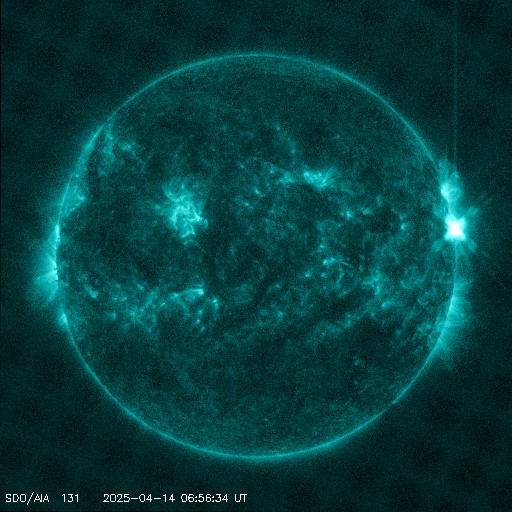Viewing archive of Thursday, 25 March 2010
Solar activity report
Any mentioned solar flare in this report has a scaling factor applied by the Space Weather Prediction Center (SWPC). Because of the SWPC scaling factor, solar flares are reported as 42% smaller than for the science quality data. The scaling factor has been removed from our archived solar flare data to reflect the true physical units.
Report of Solar-Geophysical Activity 2010 Mar 25 2201 UTCPrepared by the NOAA © SWPC and processed by SpaceWeatherLive.com
Joint USAF/NOAA Report of Solar and Geophysical Activity
SDF Number 084 Issued at 2200Z on 25 Mar 2010IA. Analysis of Solar Active Regions and Activity from 24-2100Z to 25-2100Z
Solar activity has been at very low levels for the past
24 hours. Region 1057 (N15E45) has shown steady growth in area (400
millionths) and is still classified as a D group. Several B-class
flares were observed from Region 1057, the largest being a B7,
optically uncorrelated event, at 25/0433Z. A far-sided CME was
observed at 25/0128Z with an associated Type II radio sweep (shock
velocity 1395 km/s), but does not look to be geoeffective. Region
1058 (N27W06) was numbered today and is classified as a simple A
group.
IB. Solar Activity Forecast
Solar activity is expected to be at
very low to low levels. There is a chance for C-class flares from
Region 1057.
IIA. Geophysical Activity Summary 24-2100Z to 25-2100Z
The geomagnetic field has been at quiet to unsettled levels for the
past 24 hours. Solar wind observations from the ACE spacecraft
showed an increase of wind speed from 300 to 430 km/s following a
rise in density (1 to 22 p/cc). These signatures are indicative of a
co-rotating interactive region in advance of a weak coronal hole
high-speed stream.
IIB. Geophysical Activity Forecast
The geomagnetic field is
expected to remain at quiet to unsettled levels for day one (26
March) as the effects of the coronal hole high-speed stream subside.
On day two (27 March), quiet levels are expected. On day three (28
March), the geomagnetic field is expected to be at quiet to
unsettled levels as a new coronal hole high-speed stream becomes
geoeffective.
III. Event Probabilities 26 Mar to 28 Mar
| Class M | 05% | 05% | 05% |
| Class X | 01% | 01% | 01% |
| Proton | 01% | 01% | 01% |
| PCAF | green | ||
IV. Penticton 10.7 cm Flux
Observed 25 Mar 088 Predicted 26 Mar-28 Mar 088/089/089 90 Day Mean 25 Mar 083
V. Geomagnetic A Indices
Observed Afr/Ap 24 Mar 002/003 Estimated Afr/Ap 25 Mar 005/007 Predicted Afr/Ap 26 Mar-28 Mar 005/005-005/007-007/008
VI. Geomagnetic Activity Probabilities 26 Mar to 28 Mar
| A. Middle Latitudes | |||
|---|---|---|---|
| Active | 20% | 05% | 20% |
| Minor storm | 01% | 01% | 05% |
| Major-severe storm | 01% | 01% | 01% |
| B. High Latitudes | |||
|---|---|---|---|
| Active | 10% | 05% | 20% |
| Minor storm | 01% | 01% | 05% |
| Major-severe storm | 01% | 01% | 01% |
All times in UTC
Current data suggests there is a slight possibility for aurora to appear at the following high latitude regions in the near future
TórshavnOulu
Reykjavik
Luleå
Latest news
Latest forum messages
AR 4055 992025/04/12-13 Filament CMEs 2025/04/16 G2 Watch 38Incoming & Unnumbered Active Regions 1700Unspecified geomagnetic activity 2258Potential AR4062 8
More topicsSupport SpaceWeatherLive.com!
A lot of people come to SpaceWeatherLive to follow the Sun's activity or if there is aurora to be seen, but with more traffic comes higher server costs. Consider a donation if you enjoy SpaceWeatherLive so we can keep the website online!

Latest alerts
Monday, 14 April 2025
23:15 UTC - Geomagnetic activity
Active geomagnetic conditions (Kp4) Threshold Reached: 23:01 UTC
07:09 UTC - Solar flare
Moderate M4.28 flare from sunspot region 4055
06:48 UTC - Radio Blackout
Minor R1 radio blackout in progress (≥M1 - current: M1.53)
06:24 UTC - Solar flare
Moderate M1.49 flare from sunspot region 4055
06:06 UTC - Radio Blackout
Minor R1 radio blackout in progress (≥M1 - current: M1.16)
Space weather facts
| Last X-flare | 2025/03/28 | X1.1 |
| Last M-flare | 2025/04/14 | M4.2 |
| Last geomagnetic storm | 2025/04/06 | Kp5 (G1) |
| Spotless days | |
|---|---|
| Last spotless day | 2022/06/08 |
| Monthly mean Sunspot Number | |
|---|---|
| March 2025 | 134.2 -20.4 |
| April 2025 | 132.1 -2.1 |
| Last 30 days | 130.6 -13.6 |





